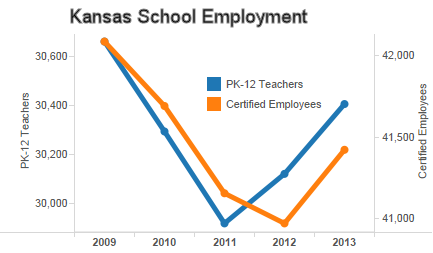 Regardless of which side wins the Kansas school finance lawsuit, we know who loses: Kansas schoolchildren.
Regardless of which side wins the Kansas school finance lawsuit, we know who loses: Kansas schoolchildren.
Talking about school spending is easy, even though most Kansas public school spending advocates refuse to acknowledge the totality of spending. (Or if they acknowledge the total level, they may make excuses for the spending not being effective.) Advocating for more spending is easy. It’s easy because the Kansas Constitution says the state must spend on schools. Parents want more spending, and so do teachers, public employee unions, and children. It’s easy to want more spending on schools because anyone who doesn’t is demonized as anti-child, anti-education, and even anti-human.
But the focus on school spending lets the Kansas public school establishment off the hook too easily. Any and all shortcomings of Kansas schools can be blamed on inadequate funding, and that’s what happens.
The focus on school spending also keeps attention away from some unfortunate and unpleasant facts about Kansas schools that the establishment would rather not talk about. Kansas needs to confront these facts for the sake of Kansas schoolchildren. If the court orders more spending and the legislature complies, not much is likely to improve, but the public school establishment will say everything that’s wrong has been fixed.
The focus on spending
First, citizens are generally misinformed on Kansas school spending. In surveys, most people usually guess that schools spend less than half of the correct amount. It’s a problem not only in Kansas; it’s a nationwide issue.
Then, there is a tenuous connection between increased school spending and better student outcomes. Many studies point out the rapid rise in school spending over the decades, but test scores are flat.
Public school spending advocates say that increased spending will allow smaller class sizes. But class size reduction is very expensive and produces only marginal benefits compared to other strategies. The Center for American Progress — normally in favor of anything that increases government spending — wrote this in its 2011 report The False Promise of Class-Size Reduction”
The evidence on class size indicates that smaller classes can, in some circumstances, improve student achievement if implemented in a focused way. But CSR [class size reduction] policies generally take exactly the opposite approach by pursuing across-the-board reductions in class size at the state or federal level. These large-scale, untargeted policies are also extremely expensive and represent wasted opportunities to make smarter educational investments. Large-scale CSR policies clearly fail any cost-benefit test because they entail steep costs and produce benefits that are modest at best.
The CAP report tells readers what does work to improve student outcomes:
Researchers agree that teacher quality is the single most important in-school determinant of how much students learn. Stanford economist Eric Hanushek has estimated that replacing the worst 5 percent to 8 percent of teachers with average teachers would dramatically boost achievement in the United States.
But Kansas ranks low in policies regarding teacher quality. The current lawsuit doesn’t address issues like teacher quality or other specific reforms that will actually help Kansas schoolchildren.
What Kansas did after the last lawsuit
Consider what Kansas did the last time schools won a lawsuit: The state lowered its school standards. Simply put, Kansas didn’t have rigorous standards for its schools, and it lowered them after the last court decision.
The National Center for Education Statistics produces a report titled Mapping State Proficiency Standards Onto the NAEP Scales. (NCES is the primary federal entity for collecting and analyzing data related to education in the U.S. and other nations, and is located within the U.S. Department of Education and the Institute of Education Sciences.)
The mapping project establishes a relationship between the tests each state gives to assess its students and the National Assessment of Education Progress, a test that is the same in all states. The conclusion of NCES is that Kansas school standards are relatively low, compared to other states. This video explains. (View below, or click here to view in HD at YouTube.)
For Kansas, here are some key findings. First, NCES asks this question: “How do Kansas’s NAEP scale equivalent scores of reading standards for proficient performance at grades 4 and 8 in 2009 compare with those estimated for 2005 and 2007?”
For Kansas, the two answers are this (emphasis added):
“Although no substantive changes in the reading assessments from 2007 to 2009 were indicated by the state, the NAEP scale equivalent of both its grade 4 and grade 8 standards decreased.”
Also: “Kansas made substantive changes to its reading grade 8 assessment between 2005 and 2009, and the NAEP scale equivalent of its grade 8 standards decreased.”
In other words, NCES judged that Kansas weakened its standards for reading performance.
A similar question was considered for math: “How do Kansas’s NAEP scale equivalent scores of mathematics standards for proficient performance at grades 4 and 8 in 2009 compare with those estimated for 2005 and 2007?”
For Kansas, the two answers are this (emphasis added):
“Although no substantive changes in the mathematics assessments from 2007 to 2009 were indicated by the state, the NAEP scale equivalent of its grade 8 standards decreased (the NAEP scale equivalent of its grade 4 standards did not change).”
Also: “Kansas made substantive changes to its mathematics grade 4 assessment between 2005 and 2009, but the NAEP scale equivalent of its grade 4 standards did not change.”
For mathematics, NCES judges that some standards were weakened, and some did not change.
In its summary of Kansas reading standards, NCES concluded: “In both grades, Kansas state assessment results showed more positive changes in achievement than NAEP results.” For mathematics, the summary reads: “In grade 4, Kansas state assessment results showed a change in achievement that is not different from that based on NAEP results. In grade 8, state assessment results showed a more positive change.”
In other words: In three of four instances, Kansas is claiming positive student achievement that isn’t apparent on national tests.
Following are two examples of charts from the NCES study where Kansas school standards rank compared to other states. Click on them for larger versions.














 This week the
This week the